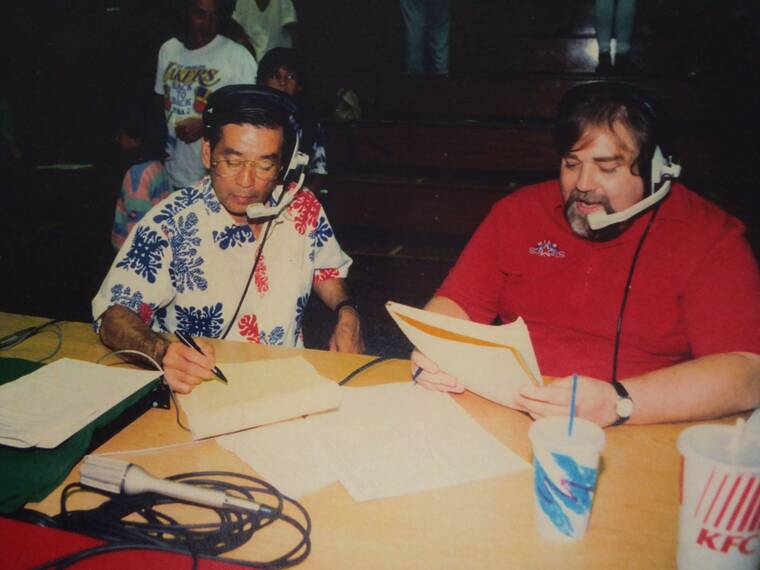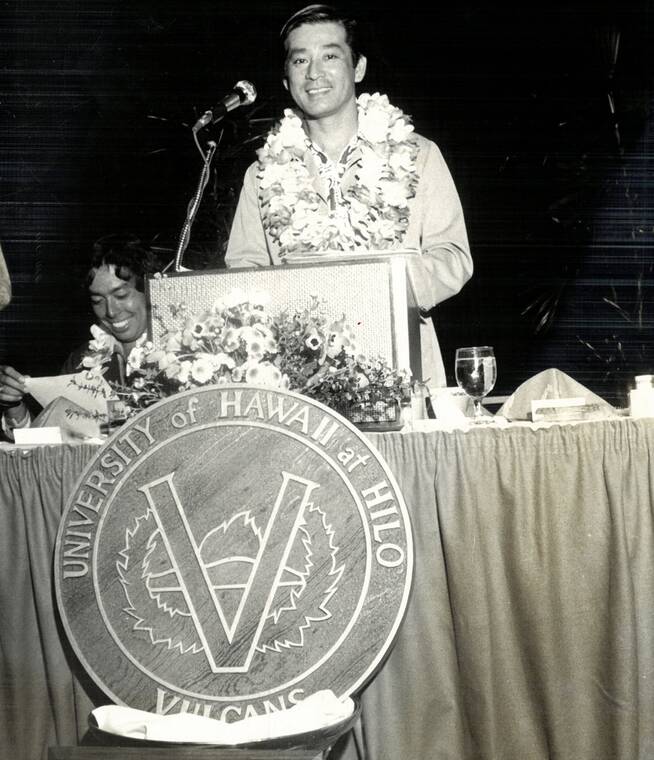CORRECTION: A previous version of this story had an incorrect year and division for Hawaii Pacific University’s national title in basketball. The Tribune-Herald regrets the error.
“A person like Jimmy — and there are a lot of them in our community — they belong to the community, beyond their families.”
According to Jeanne Yagi, a large number of people visited her husband, Jimmy Yagi, during his final days at Hilo Medical Center, where he died Wednesday of natural causes at 88.
Coach Yagi, who died peacefully with his wife and two sons, Kirby and Brady, at his side, was a legend for turning the University of Hawaii at Hilo Vulcans from a club-level team to a collegiate contender in the mid-to-late 1970s.
“He’s the nicest person I ever met,” said Bill O’Rear, retired Tribune-Herald sports editor, who came to Hilo in 1976 from Santa Rosa Junior College to play on Yagi’s first team that competed at an intercollegiate level.
“Coach Yagi was only 5-foot-6, but he was a giant of a man,” added Pat Guillen, UH-Hilo’s athletic director and a close friend of the coach. “And it sounds like a cliche, but when you were around Coach Yagi, you knew you were around greatness.”
Yagi and then-UH-Hilo Athletic Director Ramon Goya were the architects who took the hometown program that played against junior colleges, senior league clubs and military teams, to competing in the National Association of Intercollegiate Athletics.
The move was successful, as the Vulcans went 23-3 in 1976-77 and beat NCAA Division I Nebraska and New Mexico — the latter featuring former Los Angeles Lakers star Michael Cooper. In 1977-78, the Vulcans went 27-5.
In both seasons, UH-Hilo won District 2 championships and made it to the second round of the NAIA National Tournament in Kansas City, Mo.
Yagi’s was a Horatio Alger-type success story. He was an unsalaried volunteer coach at first, making his living at Kulana Foods, his family’s meat-processing outfit.
“He started at three in the morning, and he worked all day there,” O’Rear said. “Then, he’d go to practice, and he’d coach the team. He and Ramon Goya were the backbone of the UH program.”
As with many success stories, timing played a significant role.
In 1975, the Vulcans scheduled the University of Nevada at Las Vegas, coached by Jerry Tarkanian, at the then-Hilo Civic Auditorium. The game set a record, with the Vuls on the losing end of a 164-111 score. But the game ball ended up in the College Basketball Hall of Fame.
“That kind of set us up, because that was Gilbert Hicks’ first year, and he was a great player,” O’Rear said.
Yagi and Goya also met a couple of California junior college coaches, Herb Livsey of Orange Coast College in Costa Mesa, and Bill Trumbo of Santa Rosa JC — who later became UH-Hilo’s athletic director — both of whom took a shine to the humble Hilo coaches and started a player pipeline of junior college transfers to the Vulcans.
In 1976, Jay “The Bird” Bartholomew and O’Rear transferred from Santa Rosa to UH-Hilo as juniors.
“That season, we went NAIA,” O’Rear said. “We won the district, and we went on to the nationals. We lost in the second round to Jack Sikma and Illinois Wesleyan.”
And with UH-Manoa on NCAA probation and a woeful 1-26 — causing Rainbows fans to wear paper bags with eye holes on their heads at games — Hawaii caught “Vulcan Fever” in 1976-77. Five UH-Hilo games, including district and national tournament games, were broadcast on statewide TV.
“In ’76-77, a District 2 team had not won a tournament game in 13 years,” O’Rear said. “And (the late Honolulu Star-Bulletin sportswriter) Jim Easterwood wrote a column saying he would eat his sombrero if we led at halftime in Kansas City.
“We won, of course. And he had a cake made that looked like a sombrero, and he sent a picture to us eating his hat.”
In addition to Bartholomew and O’Rear, standouts on that team included Mark Lovelace, Tom “The Truck” Ziemantz, David Corbelli, Terry Huffman and Dan Singleton. Other important contributors included Rama Camarillo, Doug Cameron, Steve Coccimiglio, Bill Naylor and Bill Walling.
And on the sidelines, exuding a Yoda-like calm, was Yagi.
“He was always calm. And that made you feel like everything is OK,” O’Rear said.
Yagi remains the winningest coach in UH-Hilo’s history, with a 218-87 record in 12 NAIA seasons.
“In athletics, he set a standard that is going to be hard for any coach to come in and replicate,” Guillen said. “He gave us all something to shoot for. Not just winning, in our various programs, but also as a person and as a role model.”
Yagi and Goya created the blueprint for the rise of other Hawaii small-college dynasties. That includes Chaminade, which knocked off NCAA Division I top dog Virginia with Ralph Sampson in 1982, and Hawaii Pacific University’s NAIA Division I national title in 1993.
O’Rear and Guillen said that Yagi’s four decades of youth basketball camps are as vital as the hoops program he helped build.
“He had such an impact with the youth throughout the state,” O’Rear said. “And I think, what people don’t realize, is a lot of times, when these coaches go out and teach camps, they always want to teach the best players. And Coach Yagi would tell Coach Hamilton (Manley) and myself, ‘We coach anybody’s children.’
“That’s what he believed in, just trying to help people feel better about themselves, so they would go on and do other things in their life with more confidence.”
Guillen said Yagi “embodied everything that is truly meaningful about the aloha spirit.”
“I learned so much from him when I got here,” he said. “And most of it was about life — how you treat other people, becoming a better listener. And he used basketball to teach all those life skill to the kids.
“We’re continuing to call it the Jimmy Yagi Camp to honor his legacy.”
Funeral arrangements are pending.
Email John Burnett at jburnett@hawaiitribune-herald.com.


